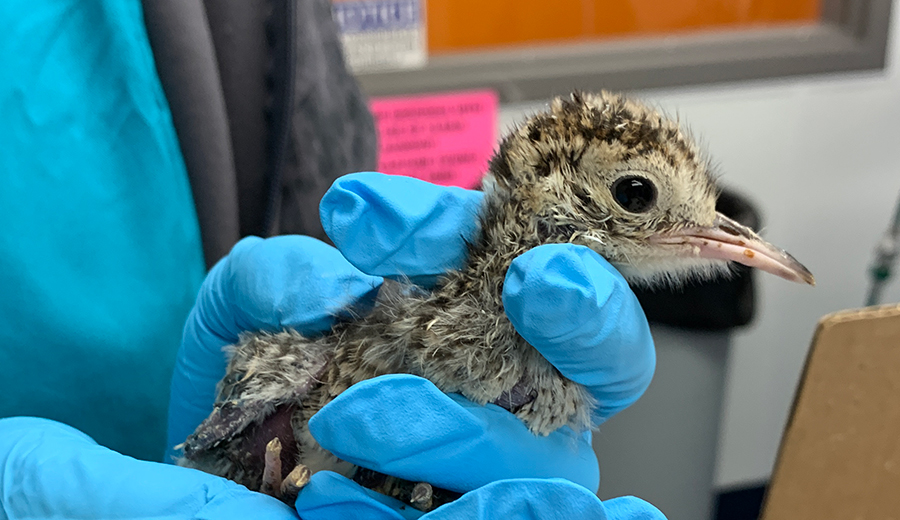Seek Help If Your Fish Exhibits Abnormal Behaviors
Of course you’d take your cat or dog to see a veterinarian when there’s a health concern. But what do you do when your sick pet is a fish?
Leslie, a third-year student at the University of Illinois College of Veterinary Medicine, noticed something odd on her betta fish Francisco. So she took him to the college’s Veterinary Teaching Hospital to see Dr. Krista Keller, a veterinarian who is a board-certified specialist in zoological medicine.
Spotting the Problem
“Francisco is a three-year-old male betta fish,” Leslie says. “He lives by himself in a five-gallon fish tank with glass stones for substrate and a few plastic plants that he likes to nap on.” He gets his water changed weekly to keep him happy and healthy.
![[Francisco in his five gallon tank]](https://vetmed.illinois.edu/wp-content/uploads/2021/04/pc-keller-francisco-2-225x300.jpg)
“Francisco was still acting normal and eating well, but I know that animals often hide symptoms of illness until they are very sick,” Leslie explains. “I reached out to Dr. Keller, who sees fish, to set up an appointment.”
Sick betta fish can show various signs. They may appear bloated and not able to rise to the water’s surface. They may have spots on their body or ragged fins. If the gills are infected or inflamed, they can experience respiratory distress.
“Infections are among the more common reasons we see fish,” says Dr. Keller. “Infections may be parasitic, bacterial, or fungal in nature, and they may be introduced when a new fish is added to the tank.”
Examining a Fish
A veterinary visit for a fish follows many of the same steps as for a dog, horse, or other mammal. First the veterinarian gets a history from the owner, then she observes the animal, and finally does a hands-on examination before deciding whether diagnostic tests are needed.
“Prior to a physical examination, a full husbandry review is performed,” Dr. Keller explains, “where we ask questions about the fish’s environment, food sources, and water quality.” This step helps a veterinarian determine the risk factors for disease.
Water quality is a major factor in fish health. Poor water quality, such as too high or too low temperatures or dirty water, can weaken the fish’s immune system and make it more susceptible to illness.
During the hands-off examination, the veterinarian observes the animal patient to see how it is moving and acting. For fish, the veterinarian looks for the fish’s ability to swim and maintain buoyancy in the water column.
Next comes the hands-on physical exam.
“Francisco was anesthetized with a powder that was applied to his water so that as he took breaths, he would become anesthetized,” Leslie says. “Then the veterinarian checked his eyes, mouth, gills, and overall condition.”
Having a fish anesthetized during an examination allows the veterinarian to safely handle the fish and reduces stress on the fish. Many parts of the examination require the fish to be out of water for a brief period of time. For Francisco, Dr. Keller performed a mucus scrape, a gill clip, and a scraping of the lesion. These samples were placed on a glass slide. The scrapings were then examined under the microscope for parasites and abnormal cells. There were no abnormal findings on any of these tests.
“If a fish requires surgery, they are anesthetized and placed on a surgical table,” Dr. Keller explains. “It is important to maintain a moist environment on the skin of the fish. The skin cannot be allowed to dry out.”
Dr. Keller prefers to place soft sponges moistened with water around the fish to keep it moisturized.
Diagnostic Tests
“Once we knew that parasites were not the cause of Francisco’s lesion, we elected to take a biopsy of the abnormal fin and send it to the University of Illinois Veterinary Diagnostic Laboratory for an answer,” Dr. Keller says. A biopsy refers to a piece of tissue taken for analysis. In Francisco’s case, this tissue consisted of a fin clip.
The pathology results showed that Francisco’s fin had a deep (under the skin) bacterial infection present, and the pigment change suggested chronic inflammation.
“Because Francisco’s biopsy removed the entire lesion on his fin, it was both diagnostic and therapeutic,” Dr. Keller explains. To help heal the biopsy site, a low concentration of salt was added to the water in his tank.
Many fish medications are administered via the water in the tank. These medications act topically and are absorbed through the bloodstream. Other medications are given orally via medicated feed; however, this delivery method is not feasible for a fish that is too sick to eat. For that reason, there are also injectable medications available for veterinary use.
When to Seek a Veterinarian
“Any time fish are exhibiting behaviors that are not normal for them, changes in buoyancy or appetite, skin lesions, or enlarged belly, I recommend seeking veterinary advice,” Dr. Keller says.
Dr. Keller explains that there are a few veterinarians who exclusively work on companion fish, with most fish veterinarians practicing in the aquaculture industry or at fish farms.
The initial cost of a fish varies greatly based on the species and location of purchase. Despite this, Dr. Keller emphasizes “It doesn’t matter how much a fish may have cost, as the bond between a fish and their human family members can be quite strong.
“Taking an animal to the veterinarian can be scary, whether the animal is furry, finned, feathered, or otherwise,” she says. “Call ahead to the veterinary practice to make sure they include fish among the patients they treat. Then you can feel more comfortable that the experience will be a positive one.”
If you have any questions about your fish and their veterinary care, contact your local veterinarian. If you need to find a veterinarian that works with fish in your area visit https://www.fishvets.org/tools/locator/locator.asp?id=30.
By Beth Mueller

![[Francisco the betta fish]](https://vetmed.illinois.edu/wp-content/uploads/2021/04/pc-keller-franciso.jpg)


